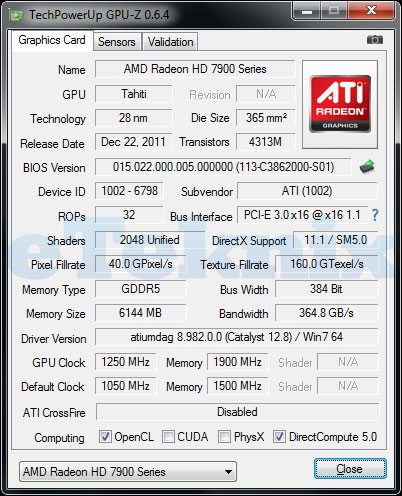Sapphire Radeon HD 7970 Vapor-X OC 6GB Graphics Card Review
Chris Hadley / 12 years ago
We’ve seen so far that the card has a lot of performance on tap, but as with all things hardware, there is always the scope for pushing things that little bit further. With this in mind we now endeavour to see how well each piece of hardware that we get in and we think is worthy of, gets our overclock treatment to take things right up to the next level.
To test our overclocks, we decide to stick to what we know best for overclocking, MSI’s Afterburner software, along with GPU-z, Furmark and 3DMark 11.

Like any other card that I overclock, it is key to find out how far the core and memory clocks go in their own right so that a rough ballpark figure of combined clock speeds can be established. Starting off with the core clock speed for a change, reaching 1280MHz was easily reached with no hassle at all, however we found that at 1290MHz, Furmark starting to suffer from some artifacting, indication that this was not so stable. Moving on to the memory clock speed and onto one of the biggest surprises I’ve had in a while. It was only a little while ago that I managed to get the memory on a 660Ti to pass 1800Mhz, but for Sapphire’s 7970, this was all but child’s play. with 1900MHz soon coming and going, MSI’s Afterburner was quickly running out of scope to go any further. Sadly though I was not able to make the 2000Mhz mark on the memory with it falling just short but so close at 1960MHz ( whopping 7.84GHz effective).
Considering the separate clock speed achieved and from past experiences, I was expecting the combined best to be a lot lower than each of these figures however this again was to throw up a surprise with only a slight drop on each required, leaving us with 1250MHz on the core clock (19% gain) and 1900 on the memory clock (27% gain). Checking this combined clock is stable is acheived by passing the card through 3DMark11 a couple of times in succession to push the card in every way it can.
Following the overclock, the card then went through all the benchmark test once more and we found that across the board there was an increase in frame rates, with Heaven seeing an increase of 18fps at 1920 and AvP seeing a huge increase in performance of 22fps at 1680×1050 and 17fps at 1920×1080.



















